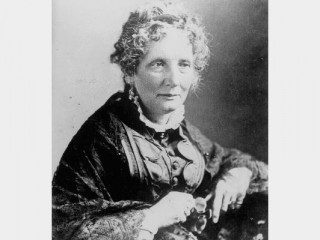
Harriet Elizabeth Beecher Stowe biography
Date of birth : 1811-06-14
Date of death : 1896-07-01
Birthplace : Litchfield, Connecticut, United States
Nationality : American
Category : Arts and Entertainment
Last modified : 2010-10-06
Credited as : Writer, wrote "Uncle Tom's Cabin", " Dred: A Tale of the Great Dismal Swamp"
0 votes so far
Harriet Beecher Stowe's personality and her work are mint products of her culture. They represent a special combination of rigid Calvinist discipline (fight against it though she tried), sentimental weakness for the romanticism of Sir Walter Scott and Lord Byron, and a crusading sense of social and political responsibility.
"Hattie" Beecher was born in Litchfield, Conn., on June 14, 1811, into a family of powerful and very demanding individuals. Her father, Lyman Beecher, was a fiery, evangelical Calvinist who drove his six sons and two daughters along the straight and narrow path of devotion to God, to duty, and to himself. Her mother, Roxana Foote Beecher, died when she was 4, leaving a legacy of quiet gentleness and a brother--the Beecher children's uncle Samuel Foote. Uncle Sam, retired sea captain, brought a sense of romance and adventure into the household, as well as a measure of warm tolerance which might otherwise have been absent.
In October 1832 the family moved to Cincinnati, where the elder Beecher became director of the Lane Theological Seminary and where his older daughter, Catherine, opened her Western Female Institute, a school in which Harriet taught.
In 1834 she began writing for the Western Monthly Magazine and was awarded a $50 prize for her tale "A New England Sketch." Her writing during the next 16 years was to be sketchy indeed, for on Jan. 6, 1836, she married Calvin Ellis Stowe, a professor in the Lane Seminary, and they had seven children during a period of financial hardship. At the same time she did, however, have the opportunity to visit the South, and she observed with particular attention the operation of the slave system there. The atmosphere at the Lane Seminary was abolitionist in the extreme, but Harriet herself did not at that time espouse this position. In 1849 she published her first volume, The Mayflower, a slender book but one which convinced her husband that she should aspire seriously to a literary career.
Uncle Tom's Cabin
In 1850 Calvin Stowe was called to a chair at Bowdoin College in Brunswick, Maine, where they had their last child. She then set about writing Uncle Tom's Cabin, which first appeared in serial form in 1851-1852 in the National Era, a Washington, D.C., antislavery newspaper. The book was published in 1852 in a two-volume edition by the house of John P. Jewett and sold 300,000 copies in its first year--10,000 in the first week. During the first 5 years of its publication, the book sold half a million copies in America alone.
Though Uncle Tom's Cabin was received with wild attention, its reception was (except for the abolitionist press) almost uniformly hostile. Not only in the South, where each newspaper was a sea of fury, but also in the North there were universal charges that the world of the slave had been melodramatically misrepresented. The action of the book traces the passage of the slave Uncle Tom through the hands of three owners, each meant to represent a type of Southern figure. The first is a benevolent planter, the second a highbred gentleman, and the last the infamous Simon Legree, who causes the death of Uncle Tom. The fortunes of the slaves in the book curve downward, and the finally successful dash for freedom taken by George and Eliza constitutes the high drama of the book. But the overall treatment of slave and master reveals something far more complex than an abolitionist tract: the high, eloquent style contains much that is warmly, even fiercely sympathetic to the world of the old South.
Stowe answered her critics in 1853 with A Key to Uncle Tom's Cabin, a book designed to document the facts of the novel, but she also responded to her success by traveling widely, receiving in England and on the Continent a perfect wave of acclamation. In 1856 she published her novel Dred: A Tale of the Great Dismal Swamp. This, too, was a slave novel, and its reception was hardly less enthusiastic than that of Uncle Tom's Cabin. In England alone, during the first month, over 100,000 copies were sold. Although Stowe then turned to a less didactic dimension, producing a series of novels based on New England and drawing heavily on local color, her reputation for years to come was connected with the didactic power of her first two novels. Indeed, when she was introduced to Abraham Lincoln in 1862, he is said to have exclaimed, "So this is the little lady who started our big war!"
Later Years
In 1869 Stowe again toured Europe, renewing an earlier friendship with Lord Byron's widow. As a result, the novelist published Lady Byron Vindicated (1870), charging the dead poet with having so violated his marriage vows as to have had an incestuous relationship with his sister. Byron was a legend by this time, and the charges resulted in alienating much of Stowe's hitherto loyal British audience. Undisturbed, however, she continued her series of novels, poems, and sketches, as well as her autobiography, never wanting for a devoted and enthusiastic American audience.
The later years of her life were spent, in large part, in Florida, where she and her husband tried, with only moderate success, to manage the income from her literary activities. Stowe died in Hartford, Conn., on July 1, 1896.
















